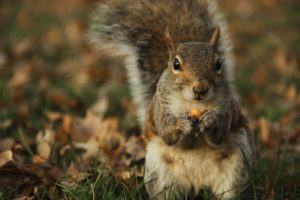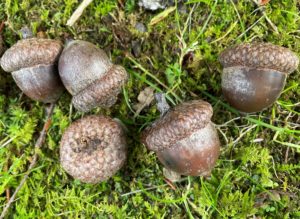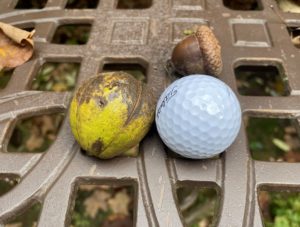Hello fellow readers, These are nutty times—far nuttier than usual. Have you noticed the plentiful tree nuts as compared to last year? In my neck of the woods, the shagbark hickory nuts are overabundant and golf ball size. So much, so that walking amongst them is risky for ankle stability. It’s called masting when there is an excess of nuts. But how do trees know when to dial up the volume for a mast year?
Nature’s way of controlling populations
A few weeks ago, we spoke about Dr. Doug Tallamy’s talk about his new book The Nature of Oaks (link below) and why there aren’t the same number of nuts each year. Mother Nature’s way of checks and balances is also called predator satiation. In a nutshell (couldn’t resist), the hypothesis is same species of plants simultaneously produce more seed or nuts than can be consumed by animals so that the plant will have plentiful seeds and nuts to reproduce. And other years when there are few or no nuts, squirrels, chipmunks, blue jays, turkeys, etc., may starve, keeping populations in check.
“What happened to all of the squirrels?”

Photo by Yiran Yang on Unsplash
Throughout the growing season, many of you asked, “what happened to all of the chipmunks and squirrels,” especially in Sparta, NJ, and surrounding areas. The two-night freeze over Mother’s Day 2020 destroyed buds that turn into nuts, severely limiting the fall harvest critters rely on.
Then came winter with frequent snow, one dumping three feet that lasted for a month, finishing off struggling populations. Chipmunks hibernate, so many weren’t as severely affected.

Photo by alex lauzon on Unsplash
Opposite our decline, Farmer’s Almanac posted a story, What’s Going on With All the Dead Squirrels? (updated July 14, 2021) explaining that 2020 was a mast year in Maine, causing a bump up in squirrel populations. This year more squirrels there are competing for fewer nuts and are taking risks to find them. Hence why far more than usual are killed crossing roads. The same is true in New Hampshire.
The story spurred many readers’ reports of no or far fewer squirrels and chipmunks in our neck of the woods. Some surmise it has to do with 5G, though others with 5G towers respond that their populations are plentiful. Others think they are getting into poison, having seen dead ones, not hit by cars.
Scientists aren’t sure what triggers mast years.
 We’ve all heard the folklore that an abundance of nuts means a severe winter ahead right up there with the theory that the narrower the brown-band on woolly bear caterpillars, the harsher the winter. But neither of them is scientifically proven.
We’ve all heard the folklore that an abundance of nuts means a severe winter ahead right up there with the theory that the narrower the brown-band on woolly bear caterpillars, the harsher the winter. But neither of them is scientifically proven.
And scientists aren’t exactly sure what causes mast years, though theories of environmental reasons, available pollen, and chemical signaling are likely.
Yes, untimely freezes can kill buds, and wet and cool springs can impact pollination just as dry, hot summers influence the size of fruits and nuts. But the specific triggers for mast years, which occur every two to five years, are not definitive.
Trees grow more slowly during Mast Years.
Large oaks can produce 10,000 acorns in a mast year— ten to twenty times more than average. And trees grow more slowly when masting as they put energy into making nuts.
While this year’s bounty may recover the lesser populations of squirrels and chipmunks, it will also boost the fertility of deer. More deer, more deer ticks, more Lyme disease. Dang.
 Speaking of woolly bears— this year, I notice many anomalies of all brown and all-black caterpillars crossing the road during walks with Jolee, who is fascinated by them. And annoyed by them too when she gets into play position, and the fuzzy fella doesn’t reciprocate.
Speaking of woolly bears— this year, I notice many anomalies of all brown and all-black caterpillars crossing the road during walks with Jolee, who is fascinated by them. And annoyed by them too when she gets into play position, and the fuzzy fella doesn’t reciprocate.
I have a hilarious video of Jolee barking at a wooly bear while loudly over her ruckus; I say, “Leave it, Jolee, it’s just what they do this time of year looking for places to hunker down.” Passersby likely think I am going nutty. :^)
Garden Dilemmas? AskMaryStone@gmail.com (and your favorite Podcast App.)
Link to the previous column for more about Dr. Doug Tallamy’s talk – Native Plants, especially Oaks, are Essential.
Link to Farmer’s Almanac story, What’s Going on With All the Dead Squirrels?



